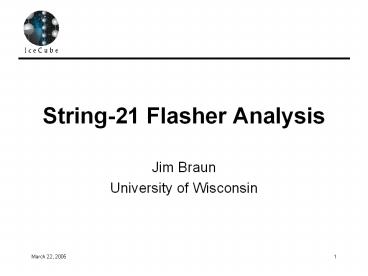March 22, 2005 - PowerPoint PPT Presentation
Title:
March 22, 2005
Description:
64 bins ATWD ch3 data for flashing DOM ... Flasher signal nearly factor of 100 ... A run similar to 1270 with clear ice above flashing DOM should be taken ... – PowerPoint PPT presentation
Number of Views:63
Avg rating:3.0/5.0
Title: March 22, 2005
1
String-21 Flasher Analysis
- Jim Braun
- University of Wisconsin
2
How can we use flasher data?
- String-21 geometry reasonably well understood
- System timing
- Provides test DOM time resolution
- Measure precision
- Detect systematic problems
- Properties of hole ice
- Differences in waveforms before and after
freeze-in may yield insight
3
Summary of available flasher data
4
Summary of available flasher data
- Pre-1270 runs
- Suffer from cable bandwidth overload
- Large gaps in data
- Use cautiously
- Runs 1270-1271
- No monolith output
- DOMs missing from upper string
- 15 deadtime
- 1.1ms offset between flasher timestamps and
events
Flashing DOM
Receiving DOMs suppressed
5
SPS runs 1270 1271
- DOM 39 (2095m) chosen randomly as flasher
- Perhaps not a good choice from standpoint of
system timing!
6
SPS run 1270 Analysis
- Use raw TestDAQ data
- Must apply trigger
- Require 4 hits within 6ms
- Events observed first by DOM 38 are flasher
events - Flasher rate - 610 Hz
- Data Format
- 32 bins ATWD ch0 data for receiving DOMs
- 64 bins ATWD ch3 data for flashing DOM
- By disabling partner of flashing DOM, cable
bandwidth of flashing DOM approximately
equivalent to bandwidth of receiving DOMs - Event rate is 515Hz
7
Run 1270 waveforms
8
SPS run 1270
- Flasher signal nearly factor of 100 stronger than
background - Most DOMs at top of string not present
- Isolated Q2 glitch
- DOM 40 disabled to maximize cable bandwidth for
DOM 39 - Dust attenuation is apparent
- .1 SPE reached at DOMs 33 and 56
- Light directed upward is suppressed
DOM 40 disabled
9
SPS run 1270
- Large number of low multiplicity IceTop events
- Typical flasher event seen by 15 DOMs
- Vertical pulse propagation of 120m
- Less deadtime shifts distribution toward higher
multiplicity
Flasher Events
IceTop noise
10
SPS run 1270
- Time between flash and observation increases
somewhat linearly for DOMs away from flasher - Subtle convex nonlinearity near flashing DOM
Nonlinearity near flasher
11
System Timing
A simple test
DOMi-2
- Enable flasher board on DOMi
- Calculate pulse arrival time differences between
the two DOMs directly above with good statistics
(105 events) - Requires time-calibrated raw timestamp and
discriminator crossing analysis of ATWD data for
precision - Width of distribution is characteristic of timing
precision - Mean of distribution is characteristic of optical
distance between DOMs
DOMi-1
DOMi
12
System Timing
- Factors affecting width
- PMT response
- ATWD bin resolution (3.5ns/bin)
- RapCal precision
- Factors affecting mean
- DOM spacing
- RapCal systematic accuracy
- Ice properties
13
SPS run 1270
17m
17m
- RMS Dt 6.3ns
- 37 38
- Mean Dt 87ns
- equivalent to 20m path length difference in ice
- Why not 17m?
- Probably an effect of dust layer
- Need to understand this
14
Where do we go from here?
- More data!
- A run similar to 1270 with clear ice above
flashing DOM should be taken - Need ability to adjust flasher rate
- Need to understand flasher timestamp offset
- Pre/post freeze-in waveform analysis
- Understand hole ice
- Pre-1270 waveforms are still OK
- Photonics simulation?
- Need to understand propagation of flasher pulse
in dust layer































